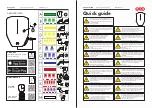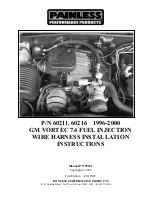
WSM.124
Section K (Brakes)
5th
re-issue
Page 27
RAPIER
Push out the handbrake pivot pin (7) and remove
the lever (6).
With the bleed screw ( I 0) In position, remove the
Inner piston (5) by applying gentle air pressure to
the fluid pipe connection.
Remove the rubber seals from each piston. It
should be noted that the metal dust cover cannot
be removed from the outer piston.
To reassemble (See Fig. 16)
Flt the tapered rubber seal into the groove In the
Inner piston with the lip facing away from the slotted
end of the piston.
Fit the rectangular sectioned seal (4) Into the groove
in the outer piston.
Insert the inner piston (5) into the wheel cylinder
body closed end first and with the longest slot In the
piston adjacent to the slot in the body. Take great
care when easing the lip of seal past the edge of the
bore not to damage or turn back the lip.
Place the handbrake lever (6) In position and refit
the securing pin.
Refit the outer piston (3) Into the bore.
Refit the wheel cylinder onto the backplate as
previously described.
HYDRAULIC SYSTEM
GENERAL
Great cleanliness is essential when dealing with any
part of the hydraulic system, and especially so where
the brake fluid is concerned. Dirty or aeriated fluid
must never be added to the system. Use only the
specified type of brake fluid for topping up t�e
reservoir. (See Section P).
BLEEDING THE SYSTEM
"Bleeding" (expelling air from) the hydraulic system
is not a routine maintenance operation, and should
only be necessary when a portion of the hydraulic
system has been disconnected or if the level of the
brake fluid in the master cylinder reservoir has
been allowed to fall so low that air has entered the
system.
Always keep a careful check on the fluid level in the
reservoir during bleeding. It is most Important that
the master cylinder be kept at least half full
otherwise air may be drawn in necessitating a
fresh start.
I. Ensure that all connections are secure, the fluid
reservoir Is topped up with brake fluid and
kept topped up during the whole operation.
Remove the rubber cap from the bleed screw
of the left hand rear wheel cylinder, fit a bleed
tube and immerse its free end in a glass vessel
containing some brake fluid.
2. Slacken off the bleed screw
½
to
¾
of a turn and
depress the brake pedal with full strokes allow
ing its return to be as quick as possible; any
check on its return will prevent effective bleed
ing. Actuate the brake pedal in this manner
until the brake fluid entering the vessel is free
of air and tighten the bleed screw on the next
downward stroke ensuring that it is fully
tightened before the pedal reaches the bottom
of Its stroke. Remove the bleed tube and glass
vessel, refit the rubber cap.
3. Repeat operations I and 2 at each of the remain
ing bleed screws, finishing at the right hand
front. In the instance of late Rapier Series IV
Cars onwards repeat operations I and 2 at the
front brakes only as the right hand rear wheel
cylinder has no bleed screw.
4. Top up the reservoir to the correct level, refit
the filler cap ensuring its seal is in good condition
and its air vent is unobstructed.
Care
should be taken
not to
over-tighen the bleed
screws since
this may very easily result in stripped
threads. For the correct torque figures
see
under
"Brakes" in the "General Data Section"
Summary of Contents for ALPINE I SERIES: APLINE II SERIES
Page 1: ......
Page 189: ...Fis 21 Ball pin heirht checkinr fixture in position Details of items 1 to 4 In Fig 22...
Page 208: ...Fla 3 Exploded view of rear axle Hypoid Bevel Drive...
Page 220: ...Page 16 WSM 12 f Section G Rear Axle 0 QQ I I I I I t 0 ii 8 ts t 0 Cl 2 i J...
Page 247: ...Page6 WSM 124 Section J Steering N Iii it...
Page 299: ...Page 40 3 6 7 8 Fis 22 Se rvo unit exploded view Sect WSM 124 ion K Brakes 18 419 GZo 21...
Page 413: ..._ PRINTED IN ENGLAND 9Y WREN PRINTING CQ LTD LONDON...
















































